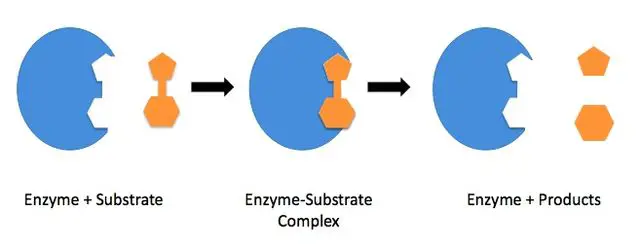A substrate is a substance that converts into a product in the presence of enzymes.
Most substrates have only one specific enzyme to convert into a specific product.
But most enzymes can catalyze the reaction of two or more substrates.
So, a substrate undergoes a chemical transformation in the presence of a specific enzyme-mediated biochemical reaction.
It cannot undergo chemical change by other enzymes.
Substrate’s role in enzyme reaction?
- An enzyme catalyzes a reaction only in the presence of a substrate.
- An increase in substrate concentration can enhance the reaction rate.
- The rate of reaction reaches its peak when the substrate saturates the enzyme.
How does the substrate-enzyme interaction occur?
A substrate (S) binds to the active site of an enzyme (E) to form an enzyme-substrate complex.
The enzyme will remain unchanged while the substrate is modified into products.
This is given as a reaction below.
S + E <========>ES <===========> P + E. {S= substrate ; E= enzyme; P= Product}

Examples of substrates
1. The Carbohydrates like sugar and starch act as substrates for enzymes like salivary amylase and maltase.
2. Amino acids, peptides, and proteins act as substrates for enzymes trypsin and chymotrypsin. These proteins are found in foods like grains, eggs, and meat.
3. Fatty acids act as substrates for lipase enzymes. Fats are obtained from food and by synthesis in the body.
4. Nucleic acids DNA and RNA are substrates for nuclease enzymes.
5. The enzyme alcohol dehydrogenase breaks down ethyl alcohol.
Other substrate examples and their role in the body
| Sl.No | Substrate | The enzyme (catalyst) | Role in the body |
|---|---|---|---|
| 1 | Starch | Amylase | Glucose source |
| 2 | Protein | Peptidase | Aminoacid source |
| 3 | Lipid | Lipase | fatty acids sorce |
| 4 | Nucleic acids (DNA/RNA) | fatty acids source | Genetic information |
| 5 | ATP | Adenylate cyclase | Energy source |
| 6 | Glucose | Hexokinase | generates ATP |
| 7 | Lactose | β-Galactosidase | generates ATP |
| 8 | CO2 | Carbonic anhydrase | Acid-base homeostasis |
| 9 | Estrogen | cytochrome P450 | Female reproductive hormone |
| 10 | Urea | Urease | nitrogen waster |
| 11 | Benzyl-penicillin | Pencillinase/ β-lactamase | Antibiotic kills bacteria |
| 12 | Angiotensinogen | Renin | Regulates blood pressure |
| 13 | Alcohol | Alcohol dehydrogenase | As medicine and intoxicant |
Neurotransmitters as substrates
Neurotransmitters are the chemical substances in the body that are involved in nerve conduction.
| Sl. No | Substrate | Enzyme name | Role |
|---|---|---|---|
| 1 | Acetylcholine | Acetylcholinesterase and butyrylcholinesterase | Parasympathetic neurotransmitter |
| 2 | Dopamine | Monoamine oxidase (MAO) and catechol-O-Methyltransferase (COMT) | |
| 3 | Nor-Epinephrine | MAO and COMT | Neurotransmitter in sympathetic system. |
| 4 | Epinephrine | MAO and COMT | Neurotransmitter in sympathetic system. |
| 5 | Serotonin | MAO and COMT | Regulates mood, cognition, reward, learning, memory, etc. |
| 6 | GABA | GABA transaminase | Inhibitory neurotransmitter |
| 7 | Glutamate | glutamate dehydrogenase & aspartate aminotransferase | Exitatory neurotransmitter. |
- When substrate concentration is increased, the reaction rate is enhanced.
- This is because there are more substrate molecules ready to undergo biochemical reactions.
- However, this enhancement of reaction is limited.
- After the substrate occupies all the active sites of the enzyme, there will be no further increase in the rate of reaction.
- So, the remaining substrate molecules must wait until the previously bound molecules are broken down and removed.
- However, after the saturation point, any further increase in substrate concentration would only lead to stable reaction kinetics.
- Besides the concentration of substrate, other factors like pH and temperature also influence the breakdown of the substrate.
Frequently asked questions and answers.
-
Is lactose a substrate?
Yes, lactose is a substrate for the enzyme lactase (beta-Galactosidase).
It is mostly found in dairy products like milk, yogurt, curd, and cheese. -
What does “substrate level phosphorylation occurs” mean?
It means the addition of a phosphate group to the chemical structure activates the substrate.
This phosphorylation is done to further biochemical reactions.
For example, glucose is phosphorylated to glucose-6-phosphate by hexokinase.
-
Why do enzymes only work on their specific substrates
Enzymes have a structural configuration in which only a specific substrate gets fixed by chemical bonds and undergo biochemical transformation.
Thank you so much for your help.